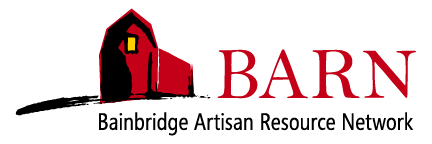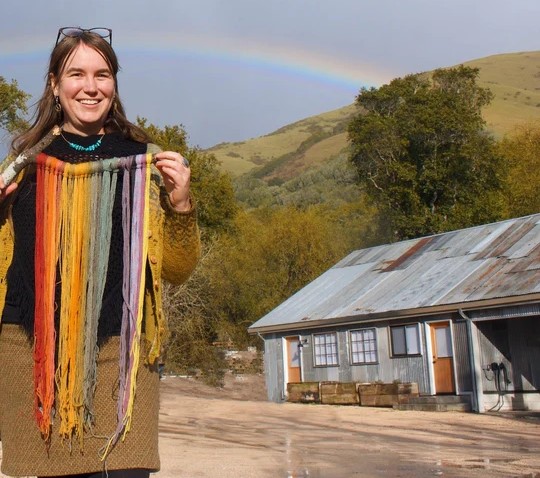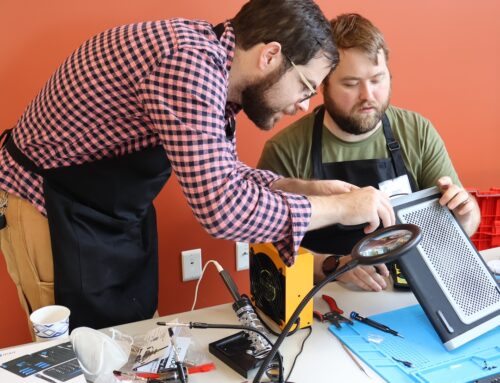Imagine a palette of colors—from rich rose and red to brilliant shades of orange, warm golds and chartreuse, mossy greens, ethereal blue greens, and deep dark purples.—drawn not from tubes or jars but from the forest floor.
This is the world of mushroom dyeing, and for three days this November, mycological enthusiast and textile artist Alissa Allen will guide BARN students through its wonders, transforming humble fungi into brilliant, tangible colors for future creations.
Alissa, the founder of Mycopigments, is passionate about fungi. Her fascination with mushrooms began in early childhood when she foraged alongside her mother. Joining the Puget Sound Mycological Society in her early 20s opened her eyes to the vast world of fungi beyond folk knowledge. She was immediately hooked. Her interest was cultivated by some of the greatest regional mycologists of that era.
Alissa was introduced to the art of mushroom dyeing in the late 1990s, before social media, when only a handful of elders were practicing the craft here on the West Coast. Armed with a now out-of-print book called “Mushrooms for Color,” she began experimenting. It would be another five years before she’d meet these elders and a few more before she was introduced to the larger international mushroom dye community.
“I was like a mad scientist,” she recalls, “I loved the whole process from heading to the forest, foraging for treasured dye species, extracting dyes and seeing the results.” This passion still runs as strong today as ever.
That one-time hobby blossomed into a full-time career in 2012, and Alissa has been teaching since then. In addition to her workshops, she has been cultivating an international community of nearly 39,000 mushroom and lichen dyeing enthusiasts on Facebook. “I set out with a goal of being a mushroom missionary, sharing widely and freely with as many people as possible,” she says.
She draws students in with the allure of vibrant, natural dyes and introduces people to the broader importance of fungi in our ecosystem. In her hands, mushroom dyeing becomes more than a craft—a way of seeing and caring for the world.
This has gotten a bit easier in recent years, as mushrooms have enjoyed a bit of a moment. (She jokes, “Mycology is mushrooming!”) She notes that it wasn’t long ago that mycophobia—fear of fungi—influenced our approach to interacting with fungi, but that trend is falling away as more people become aware of the importance of this understudied group of organisms.
“Mushrooms are just this mysterious gem,” she says of her longtime fascination. Neither plants nor animals, mushrooms constitute their own kingdom: the Fungi.
The workshop at BARN promises to be a comprehensive introduction to mushroom dyeing. Participants will learn about mushroom and lichen identification, ethical foraging practices, and extracting and using fungal dyes. Alissa will bring a variety of local specimens, both dried and fresh, showcasing the full palette of colors available in the Pacific Northwest.
“One of the things that I love is that the class features a selection of colors you can collect throughout the year,” Alissa says. “This workshop will take place at the peak of the season when the best mushrooms are out there – the reds, the blues, and the greens.”
Beyond the technical aspects of dyeing, Alissa hopes to instill in her students a deeper connection to the natural world. “Going out to find these things gives you a different relationship with the place where you live,” she explains. “You engage more intimately with the land that surrounds you.”
For Alissa, mushroom dyeing is more than just a craft: it’s a window into the complex ecology of our forests. “If we didn’t have mushrooms, the trees wouldn’t grow very tall,” she points out. “Many of the fungi used for dyes have an obligate relationship with specific trees in the forest – where the mycelium of the fungi reaches far and wide funneling nutrients and moisture back into the forest, and in exchange, the trees provide sugars created by photosynthesis to their fungal partner.” Learning about mushroom dyeing introduces you to all these components and more! Each piece of art you create tells a story of place, your place, here on this precious planet we share.
As interest in natural dyes and sustainable practices grows, Alissa’s work has found a global audience. The workshop at BARN is an opportunity to learn from one of the foremost experts in the field. Whether you’re a seasoned fiber artist or simply curious about the hidden world of fungi, Alissa’s enthusiasm and expertise promise to open your eyes to the colorful possibilities growing right beneath our feet.
Workshop Details
Mycopigments: Explore Regional Mushroom and Lichen Dyes
Learn how to dye using fungi you can forage locally!
Friday, Nov. 8 – Sunday, Nov. 10, 9 AM – 4 PM






Follow Us